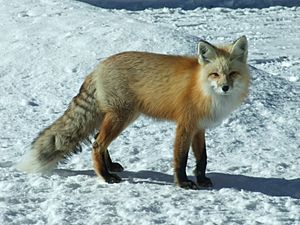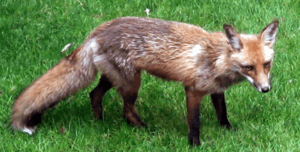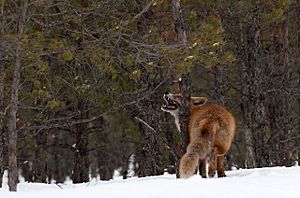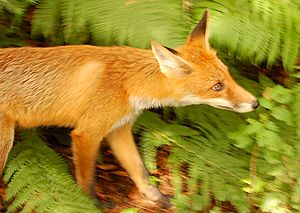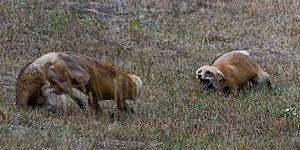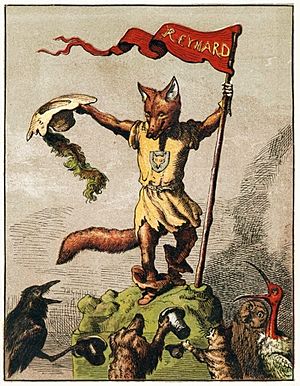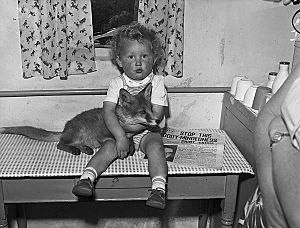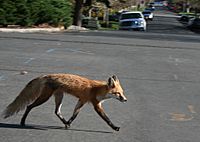Red fox facts for kids
Quick facts for kids Red fox |
|
|---|---|
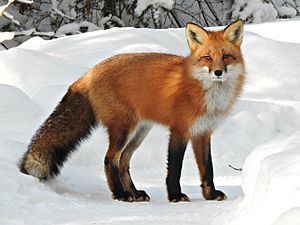 |
|
| Conservation status | |
| Scientific classification | |
| Genus: |
Vulpes
|
| Species: |
vulpes
|
| Subspecies | |
|
|
|
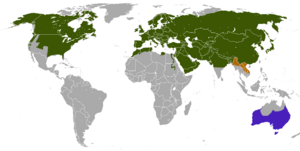 |
|
| Distribution of the red fox
native
introduced presence uncertain |
|
| Synonyms | |
|
|
The red fox (Vulpes vulpes) is the biggest of the true foxes. It is also one of the most widespread animals in the group called Carnivora. Red foxes live all over the Northern Hemisphere. This includes most of North America, Europe, and Asia, plus parts of North Africa. The IUCN says the red fox is of least concern. This means it is not currently in danger of disappearing.
Contents
- Where Do Red Foxes Come From?
- What Does a Red Fox Look Like?
- How Red Foxes Use Their Senses
- Where Red Foxes Live
- Red Fox Behavior
- Red Fox Reproduction and Life Cycle
- How Red Foxes Communicate
- What Do Red Foxes Eat?
- Who Hunts Red Foxes?
- Red Foxes and Humans
- Taming Red Foxes
- Red Foxes in Cities
- Interesting Facts About the Red Fox
- Images for kids
- See also
Where Do Red Foxes Come From?
Red foxes came from smaller fox ancestors in Eurasia. This happened a long time ago, during the Middle Villafranchian period. They moved to North America after the Wisconsin glaciation, which was a very cold time. Among true foxes, the red fox became more skilled at hunting and eating meat.
What Does a Red Fox Look Like?
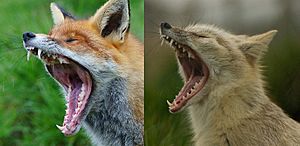
Red foxes have a long body and somewhat short legs. Their tail is very fluffy and is longer than half their body. It can reach the ground when they stand. Their front paws have five toes, but their back feet only have four. Red foxes are very quick and can jump over fences that are 2-metre-high (6 ft 7 in). They are also good swimmers.
Their skulls are quite narrow and long. Female red foxes usually have smaller skulls than males. They also have bigger canine teeth.
Red foxes are the largest type of fox in the Vulpes family. Adult foxes are usually 35–50 cm (14–20 in) tall at the shoulder. Their body length is about 45–90 cm (18–35 in), and their tails are 30–55.5 cm (11.8–21.9 in) long. They can weigh from 2.2–14 kg (5–31 lb). Female foxes, called vixens, often weigh 15–20% less than males.
Red Fox Fur Colors
In winter, a red fox's fur is thick, soft, and long.
Red foxes can have three main fur colors: red, silver/black, and cross. The most common color is reddish-rusty with yellowish parts. The front of their face and upper neck are bright reddish-brown. Their upper lips are white. The back of their ears are black or reddish-brown, while the inside is whitish. The top of their tail is reddish-brown, but lighter than their back. The underside of the tail is light grey. There is usually a black spot at the base of the tail, and the tip is white.
Even though they are called "red foxes," some can be born with other colors. This includes very pale (leucistic) or very dark (melanistic) fur.
How Red Foxes Use Their Senses
Red foxes have binocular vision, which means they use both eyes to see. However, their sight mostly reacts to movement. Their hearing is very good. A red fox can hear a black grouse moving at 600 paces away. They can also hear crows flying from 0.25–0.5 kilometres (0.16–0.31 mi) away and mice squeaking from about 100 metres (330 ft) away. They can tell where sounds are coming from very accurately. Their sense of smell is good, but not as strong as a dog's.
Where Red Foxes Live
The red fox lives in many different places around the world. Their home range covers almost 70 million km2 (27 million sq mi), reaching as far north as the Arctic Circle. They live all over Europe, in North Africa, and throughout Asia (except for extreme Southeast Asia). They are also found across North America, but not in most of the southwestern United States and Mexico. They do not live in Greenland, Iceland, or the very cold parts of central Siberia.
Red foxes are not found in New Zealand. They are listed as a "prohibited new organism" there, meaning they cannot be brought into the country.
Most red foxes like to live in open areas with lots of plants. They might go into burrows to hide from bad weather. They often dig their burrows on hills, in ravines, or near water. They can also live in places changed by humans, like ditches or neglected areas.
Red Fox Behavior
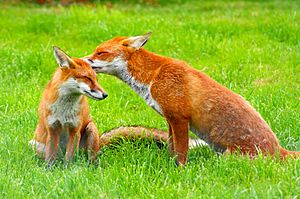
Red foxes use their urine to mark the edges of their territory.
Red foxes live in family groups that share a territory. These groups usually include a mated pair and their young. Sometimes, a male fox lives with several related females. The young foxes often stay with their parents to help take care of new baby foxes, called kits.
Young red foxes might leave their families when they become adults. This happens if they have a good chance of finding their own territory. If not, they will stay with their parents, even if it means they have to wait longer to have their own kits.
Red Fox Reproduction and Life Cycle
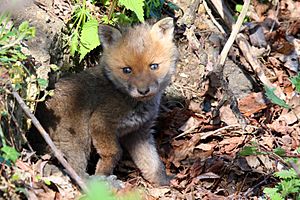
Red foxes have babies once a year in the spring. A mother fox usually has four to six kits at a time. However, some litters can have as many as 13 kits.
When they are born, kits are blind, deaf, and have no teeth. They have dark brown, fluffy fur. Newborn kits weigh about 56–110 g (2.0–3.9 oz). They are about 14.5 cm (5.7 in) long with a 7.5 cm (3.0 in) tail. They have short legs, big heads, and wide chests. Mother foxes stay with their kits for 2–3 weeks because the kits cannot keep themselves warm. During this time, the fathers or other female foxes that don't have kits bring food to the mothers.
Mother foxes are very protective of their kits. They have even been known to fight dogs to defend them. If the mother fox dies, the father fox will take care of the kits. The kits' eyes open after 13–15 days. Around this time, their ears also open, and their upper teeth start to grow. Their lower teeth appear a few days later. Their eyes are blue at first, but change to amber after 4–5 weeks. Their fur color starts to change at three weeks old.
By one month, red and white patches appear on their faces. Their ears stand up, and their snouts get longer. Kits start to leave their dens and try solid food brought by their parents when they are 3–4 weeks old. They drink their mother's milk for 6–7 weeks. Their soft baby fur starts to be replaced by shiny adult fur after 8 weeks. By 3–4 months old, the kits look more like adult foxes, with long legs and narrow chests. They reach their full adult size at 6–7 months old.
How Red Foxes Communicate
Body Language
Red foxes use their ears, tail, and body positions to communicate. Their fur markings help make these signals clearer. Their body language can show if they are being aggressive or scared. Sometimes, they show a mix of both.
- When a fox is curious, it will move its ears around and sniff.
- Playful foxes will perk up their ears and stand on their back legs.
- Male foxes trying to attract females, or after chasing away other foxes, will turn their ears outward. They will also raise their tails straight out with the tip pointing up.
- When scared, red foxes will show their teeth in a submissive grin. They will arch their backs, curve their bodies, crouch low, and wag their tails back and forth. Their ears will be pressed back against their heads.
- If they are just showing respect to a stronger fox, they will have a similar posture but without arching their back.
- When attacking, red foxes will go straight at their target. Their tails will be held high, and their ears will be turned sideways.
Vocalizations (Sounds)
Scientists have found that adult red foxes make 12 different sounds, and kits make 8. Most sounds are either "contact calls" or "interaction calls." Contact calls change based on how far apart the foxes are. Interaction calls change based on how aggressive they are feeling.
- Contact calls: The most common contact call is a barking "wow wow wow" sound with three to five parts. Foxes often make this sound when they are coming closer to each other. You hear this call most often from December to February. Each fox's "wow wow wow" call is unique. Baby foxes start making this call at 19 days old when they want attention. When red foxes get very close, they make soft, clucking sounds like chickens. Adult foxes greet their kits with low huffing noises.
- Interaction calls: When greeting each other, red foxes make high-pitched whining sounds, especially if they are submissive. A submissive fox that a dominant fox approaches will make a loud, siren-like shriek. During fights with other foxes, they make a rough, rattling sound called "gekkering." This sound is mostly heard during mating season from rival males or females who don't want to mate. Both tame and domesticated foxes have been heard making sounds like laughter. People think they use these sounds to talk to their human owners.
Another sound that doesn't fit these groups is a long, drawn-out "waaaaah" sound. Since it's heard a lot during breeding season, people think female foxes make it to call males. When a fox senses danger, it makes a single bark. If the danger is close, it's a quiet cough. If it's far away, it's a sharper bark. Kits make soft whimpering sounds when they are nursing, especially if they are unhappy.
What Do Red Foxes Eat?
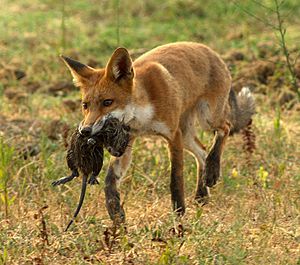
Red foxes are omnivores, meaning they eat both plants and animals. Their diet is very varied. They mostly eat small rodents like voles, mice, ground squirrels, and hamsters. They also eat birds, rabbits, porcupines, raccoons, opossums, reptiles, insects, and other small creatures. Sometimes, they eat dead animals (carrion) or things found near the water, like dead fish. Very rarely, foxes might attack young or small hoofed animals. They usually hunt animals that weigh up to about 3.5 kg (7.7 lb). Red foxes need about 500 grams (18 oz) of food each day.
Red foxes also eat a lot of plants. In some areas, fruit can make up all of their diet in the autumn. Common fruits they eat include blueberries, blackberries, raspberries, cherries, apples, and grapes. They also eat grasses and plant roots.
Red foxes are known for hunting game birds, songbirds, rabbits, and young hoofed animals. This is especially true in places where these animals are protected or raised, like farms. They also sometimes hunt chickens on poultry farms.
Red foxes prefer to hunt in the early morning before sunrise and late in the evening.
Who Hunts Red Foxes?
Red foxes often kill smaller predators, including other types of foxes. However, they can be hunted by larger animals. These include wolves, coyotes, golden jackals, and large birds of prey like golden eagles. Big cats can also be predators of red foxes.
Red Foxes and Humans
Red foxes have a long history with humans. People have hunted them for centuries because they were seen as pests or for their fur. They also appear in many stories and myths. Because there are so many red foxes and they live in so many places, they are very important for the fur trade. Red foxes are too small to be a danger to humans. They have actually done very well living near people and have moved into many suburban and urban areas. Scientists in Russia are even working to make red foxes into domesticated pets.
Red foxes are still often hunted as pests. Humans cause many red fox deaths. For example, in the UK, about 21,500–25,000 red foxes were killed in 2000. In Germany, about 600,000 were killed in 2000–2001.
Taming Red Foxes
Red foxes are generally not good pets. In the late 1900s, a Russian scientist named Dmitry Belyayev started a project to make silver foxes tame. For 40 years, he bred foxes, choosing only those that were least afraid of humans. Eventually, his team chose foxes that showed the most friendly reactions to people. This led to a group of silver foxes whose behavior and even appearance changed a lot. After about 10 generations, these foxes were no longer afraid of humans. They would often wag their tails and lick their human caretakers to show affection.
These changes in behavior also came with physical changes. The foxes started to have piebald coats (patches of different colors), floppy ears when they were kits, and curled tails. These are similar to the differences between pet dogs and wild wolves.
Red Foxes in Cities
Where Urban Red Foxes Live
Red foxes have made homes in many cities in Australia, Europe, Japan, and North America. They first moved into British cities in the 1930s and into Bristol and London in the 1940s. Later, they settled in Cambridge and Norwich. In Ireland, they are now common in the suburbs of Dublin. In Australia, red foxes were seen in Melbourne as early as the 1930s. In Zurich, Switzerland, they only started appearing in the 1980s.
City red foxes are most often found in quiet neighborhoods with many private homes. They are less common in areas with a lot of industry or businesses. In these busy areas, there are fewer foxes because they don't rely as much on human food. The area a city fox lives in can be 25–40 hectares (60–100 acres), while foxes in less populated areas might use 80–90 hectares (200–220 acres).
In 2006, it was thought that about 10,000 red foxes lived in London. City foxes might grow bigger than country foxes. This is because they have more food scraps and fewer predators. In cities, red foxes might find food in trash cans and bags. However, much of their diet is still similar to foxes in the countryside.
How Urban Red Foxes Behave
Urban red foxes are most active at dusk (evening) and dawn (morning). This is when they do most of their hunting and looking for food. It's rare to see them during the day, but sometimes they sunbathe on roofs or sheds. City foxes often make their homes in hidden, quiet spots in cities or on the edges of a city. They visit at night to find food. They sleep in their dens at night.
While urban red foxes are good at finding food in the city (and will eat almost anything humans eat), some people leave food out for them. They find the foxes charming. If people do this often, the foxes can get used to humans. They might even let people get close to them or play with them, especially the young kits.
Controlling Urban Red Foxes
Urban red foxes can sometimes cause problems for people. They have been known to steal chickens, mess up trash cans, and damage gardens. Most complaints about city foxes happen during their breeding season (late January/early February) or from late April to August when new kits are growing. In the U.K., hunting red foxes in cities is not allowed. Shooting them in a city is also not a good idea.
One way to control urban red foxes is to trap them. However, killing foxes doesn't really lower their numbers in a city. New kits or other foxes quickly move into the empty territory. A better way to control them is to keep them away from certain areas. People can use strong smells like creosote or ammonia to deter them. Cleaning up and blocking access to their dens can also stop a fox from coming back.
Urban and Rural Red Foxes
In January 2014, a red fox named "Fleet" was tracked as part of a study. Fleet was a fairly tame city fox from Hove, England. He unexpectedly traveled 195 miles in 21 days, going across the countryside to Rye. He was still traveling when his GPS collar stopped working. Fleet's journey set a record for the longest trip by a tracked red fox in the United Kingdom. His travels also showed that foxes can move easily between city and country areas.
Interesting Facts About the Red Fox
- The word "fox" comes from Old English.
- The oldest red fox fossils were found in Baranya, Hungary. They are 3.4 to 1.8 million years old.
- The red fox was brought to Australia by Europeans. There, it is considered harmful to native animals and birds.
- It is on the list of the "world's 100 worst invasive species".
- Red foxes are different from other fox species because they can quickly get used to new places.
- Male red foxes are called tods or dogs. Females are called vixens, and young ones are called kits.
- The red fox is the only fox native to Western Europe. So, in British English, it's often just called "the fox."
- There are 46 different types (subspecies) of red foxes in the world.
- Red foxes came to North America in two main groups, during different ice ages.
- The biggest red fox ever recorded in Great Britain was a male that weighed 17.2 kg (38 lb) and was 1.4-metre (4 ft 7 in) long. It was found in Aberdeenshire, Scotland, in early 2012.
- In zoos, red foxes can live up to 15 years. But in the wild, they usually live no longer than 5 years.
- Red foxes in captivity sleep about 9.8 hours per day.
- Red foxes can make many different sounds, covering five octaves.
- Red foxes seem to dislike the taste of moles. But they will still catch them alive and give them to their kits to play with.
- A study in 2008–2010 found that red foxes might use the Earth's magnetic field to help them hunt in tall grass or under snow.
- Red foxes are the main animal that carries rabies in Europe.
Images for kids
-
A red fox challenging two Eurasian badgers
-
A red fox confronting a grey fox
-
A red fox in a Birmingham garden investigating a rabbit hutch
See also
 In Spanish: Zorro común para niños
In Spanish: Zorro común para niños



